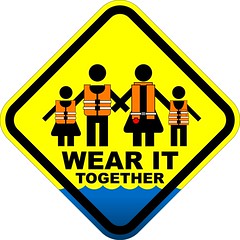This months flotilla meeting was outstanding. We had close to 30 members and 3 guests which made for a great time for fellowship and to conduct the flotilla business.
First off, I would like to thank our visitors for joining us Wednesday night. It was nice to meet you all and I hope it was a good experience for all of you. Flotilla meetings are usually the most nitty gritty function of the auxiliary but it is vital to the success of our unit. It allows us as members of a flotilla to come together and plan for the months ahead. It also allows us to get together as friend and catch up on the going on's for the month and recognize members for their hard work.
Speaking of awards.
Paul Ploeger was awarded his 2nd Operational Service Award for more then 341 hours underway this year. That is just outstanding.
Rebecca Easton was awarded her1st Sustained Service Award for 5 years of service in the Auxiliary.
Matt Epstein was awarded his 4th Sustained Service Award for 20 years of service to the Auxiliary. BZ Matt, I know your looking forward to another 20 years of service.
 Daren Lewis was officially introduced to the flotilla as District Captain elect and now represents the southern divisions. The District Captain is also responsible as a liaison for the Coast Guard Units in his area. The District Captain delegates some of this to the ASC (Auxiliary Sector Coordinator)BZ Captain Lewis on your new position.
Daren Lewis was officially introduced to the flotilla as District Captain elect and now represents the southern divisions. The District Captain is also responsible as a liaison for the Coast Guard Units in his area. The District Captain delegates some of this to the ASC (Auxiliary Sector Coordinator)BZ Captain Lewis on your new position.For the program visitors, we have some PV specific materials that you may not be aware of. The most important is the CG-5093 Manufacturer ID Code System, which is the form to sign up the marine dealers as a program partner. The biggest thing this can can do for the dealer is provide them with the quickest recall updates available. There is no yearly renewal unless the business name or location changes.
ANSC 7048 PV Activity Report is another must have. You don't get credit for your visits unless this form is filled out and SENT TO THE FSO-IS.
A program partner sticker is also available for our partners to show their customers at the front door that they care and participates as a program visitor.
A FRIENDLY REMINDER: MEMBER DUES ARE PAST DUE. PLEASE GET YOUR DUES IN TO THE FSO-FN
The Flotilla COW has changed the date to 15 January 2012 due to the Division COW being held on the 7th and would require a good number of flotilla members to participate in 2 COW that weekend. Boarding time and meal cost will be available via email soon.
We voted on a couple VERY IMPORTANT motions at the meeting this month. The first of the two motions is as follows.............. Sorry I can't tell ya on the blog what the motions were. I will have the motions available soon in the flotilla meeting minutes.
Mary Magrant conducted our member training session at the meeting which covered the steps/process to becoming an instructor (IT). The first step to gaining your qualification is to study the Instructor Development Course located at http://www.cgauxed.org/elib/idc.htm
Once finished with the course you need to log onto the E-Learning site and take an openbook, none proctored test.
Once the course and test is completed you can move onto the Personal Qualification Standard (PQS) which is a book that has tasks that must be complete in the presence of a mentor. Once this is completed, your paper work is sent to district and walla. Please call Mary for a more in depth discussion on the steps required.
VE's please remember to submit any Vessel Exam paperwork that has not been entered. The leadership would like to see your numbers accounted for this year.
EVENTS TO ADD TO YOUR CALENDER:
22 OCT Sat: ECP Training Session at MSU.
02 NOV Wed: Division Meeting
09 NOV Wed: Flotilla Meeting. Elections will be held.
12 NOV Sat: HAZWOPER Training and Exercise.
19 NOV Wed: ABS Class. Contact FSO-PE for details.







